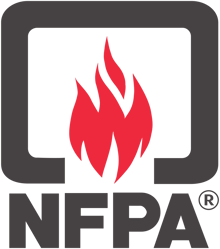
If you spend any time working with fire and life safety protocols, you’ve probably heard of the NFPA. This is one of the guiding organizations for fire safety world-wide.
But, how did they get started, and how have they changed over time? In this blog, we’re taking a crash course on the history of this important organization.
The history of NFPA
For more than 125 years, the National Fire Protection Association (NFPA) has been a self-funded nonprofit. Starting in 1896 as a Boston fire code organization, the NFPA has become the global leader in advocating for eliminating death, injury, and economic loss due to fire, electrical, and related hazards. NFPA is dedicated to supplying people with the products, services, and information they need to be safe at work and home.
The NFPA's mission is to save lives. More than 10,000 global volunteers comprise over 250 technical committees that play a vital role in the NFPA's ANSI-accredited standards development process by reviewing amendments and voting on revisions.
NFPA fire codes and standards through the decades
In 1896, NFPA published its first standard, NFPA 13, Standard for the Installation of Sprinkler Systems. The standard was designed to standardize the piping size and the spacing of sprinklers used in commercial and industrial properties within a 100-mile radius of Boston.
Shortly after, in 1897, the National Electrical Code® was published. This code was the forerunner of the Life Safety Code®, published in 1913. Since then, NFPA has published more than 300 codes and standards addressing various topics, including hazardous materials safety and fire protection in animal housing facilities.
In 2018, the NFPA released NFPA 3000™, Standard for an Active Shooter/Hostile Event Response (ASHER) Program. Spurred by a recent series of mass shootings, NFPA stakeholders launched discussions on how to address the urgent threat of active shooters, which produced a comprehensive toolbox for communities to plan for, respond to, and recover from hostile events.
The technology boom has introduced new hazards to every industry. Cybersecurity is a particularly complex challenge, as it extends to safety and security systems. The NFPA has created 16 codes and standards to address cybersecurity, including the NFPA 72, National Fire Alarm and Signaling Code.
The history of NFPA publications
In the late 19th and early 20th centuries, a time known as “The Age of the Urban Conflagration,” large American cities were devastated by fires. Cities such as New York, Pittsburgh, Chicago, Boston, Baltimore, and San Francisco were heavily damaged. To combat this issue, NFPA published the NFPA Fire Protection Handbook.
Additionally, the number of homes destroyed by wildfires each year has increased by 163 percent over the past decade. So NFPA has created Outthink Wildfire™, a comprehensive initiative designed to end the destruction of communities by wildfire in 30 years.
The most common fire codes
Knowing the codes and standards most relevant to your business and industry is critical, because they impact every aspect of your operations. NFPA codes and standards cover everything from building construction and fire prevention to electrical safety and workplace health and safety. By upholding these standards, you can help ensure your business is compliant and that your employees and customers are safe.
In addition to print publications, NFPA LINK is a digital platform that provides instant access to 1,400 NFPA codes and standards.
Here are some of the most common fire codes you need to know:
1. NFPA 13 - Standard for the Installation of Sprinkler Systems. NFPA 13 is one of the industry's most critical fire codes and the first NFPA standard to be developed. It discusses the best design and installation of sprinkler systems and how to avoid property damage or loss of life if a fire breaks out.
2. NFPA 1 - Fire Code. NFPA Code 1 enhances fire and life safety for the public, first responders, and property owners by providing a comprehensive approach to fire code regulation and hazard management.
3. NFPA 70 - Electric Code. NFPA Code 70 is the gold standard for safeguarding people and property from electrical dangers through safe electrical design, installation, and inspection.
4. NFPA 101 - Life Safety Code. NFPA Code 101 outlines ways to protect people from hazards and safety issues based on building construction, hazard protection, and occupancy guidelines. This code is especially crucial for crowd control, and concert and event safety.
5. NFPA 10 - Fire Extinguisher Guidelines. NFPA Code 10 is a code that should be known and practiced. It provides requirements and guidelines for portable fire extinguishers. By adhering to these requirements, it ensures the extinguisher works when needed the most.
See a list of more common NFPA codes.
The most common fire codes
So, why should you care about the NFPA? Well, not only are businesses legally obligated to uphold these standards and codes, along with local ordinances - the NFPA codes and recommendations also help keep your people and property as safe as possible in the case of an emergency.
We know it can be confusing, and that’s why it’s best to bring in trusted fire and life safety professionals like CertaSite to help break down all of the codes and standards, and what they mean for your unique business.

